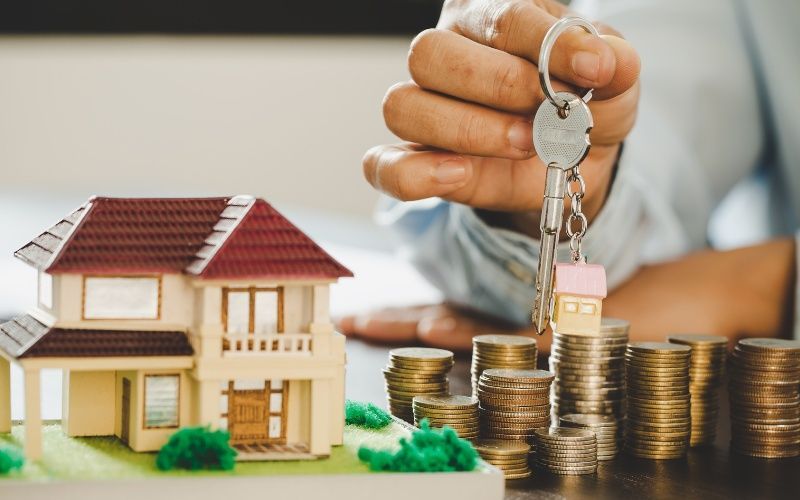Last Updated: April 4, 2024
What's the Real Deal of Owning a Home?

Disclaimer: We are not qualified legal or tax professionals and are not giving advice. Always speak with a qualified professional before making any legal or financial decisions.
Embarking on the journey of homeownership is a landmark achievement filled with anticipation and excitement. Yet, many first-time buyers find themselves navigating a maze of unexpected costs that extend far beyond the initial down payment. From appraisal fees to ongoing maintenance, understanding the true cost of owning a home is crucial to preparing your budget and avoiding financial surprises.
In this guide, we'll learn the layers of homeownership expenses, offering you a clear roadmap to financial readiness. Whether you're saving for your dream home or evaluating your budget, our comprehensive breakdown will ensure you're fully informed of the financial commitment ahead.
Want to skip the article and speak directly to a debt specialist? Click here for a free consultation.
Upfront Costs of Buying a Home
When budgeting to buy a house, your down payment amount and closing costs will be some of the first expenses you’ll encounter. Understanding how much you’ll need to pay before even moving in can help you financially prepare for the home-buying process and avoid any surprises.
Down Payment
Traditionally, mortgage rates and down payments for home purchases have been around 20% of the total home purchase price. However, there are many mortgage options that allow down payments as low as 3% to 5% for eligible first-time homebuyers.
Programs like FHA loans and HomeReady mortgages offered through Ally Bank allow qualified buyers to purchase a home with just 3% or 3.5% down. While a higher down payment of 10% to 20% will save you more money on your interest rate and avoid private mortgage insurance (PMI), lower down payment programs and mortgages such as those found on the FDIC's Affordable Mortgage Lending Center make owning a home accessible to more buyers.
On a $300,000 home purchase, you may be able to put a larger down payment of just $9,000 to $15,000 rather than having to come up with $60,000. Explore all your mortgage and down payment options before determining how much you need to save.
Closing Costs
Beyond your down payment, you’ll also need to budget for closing costs, which refer to the various fees charged to process and finalize your home purchase. Closing costs typically range from 2% of the home's purchase price to 5% of the total home price.
For a $300,000 home, you can expect to pay $6,000 to $15,000 in closing costs. Here are some of the common fees that make up your closing costs.
The Origination fees
Charged by your lender to cover underwriting and processing costs, usually 1% to 1.5% of the loan amount. On a $300,000 mortgage, this would be $3,000 to $4,500.
The Appraisal fee
Paid to the appraiser who verifies the home's value, typically $300 to $600.
The Title fees
Include title search, title examination, and title insurance, and may cost around $1,000.
The Transfer taxes
State and local taxes are charged when property changes hands, often 0.01% to 4% of the home price.
The Attorney fees
For reviewing documents and representing you, may range from $300 to $1,500.
The Home inspection
Usually, $300 to $500, is very important for identifying issues with the home before closing.
Private mortgage insurance
If your down payment is under 20% of the home price, you may have to pay a PMI of 0.5% and an interest rate of up to 2% of the loan amount per year.
As you can see, closing costs can really add up.
Having at least $10,000 budgeted for these fees on a $300,000 home purchase is a good starting point.
Work with your lender and real estate agent to get an accurate estimate of closing costs for any home you make an offer on.
Ongoing Monthly Costs
Once you've purchased your home, the expenses don't stop there. You'll take on several recurring monthly costs that should be factored into your monthly payment and your home budget. Among these costs, energy bills can be significant, but there are ways to manage them.
Here are 10 things you can do to lower your home energy bills. For more energy-saving tips and products, consider checking out Energy Star, a U.S. government-backed symbol for energy efficiency. You may also visit the U.S. Department of Energy, which provides resources on energy efficiency for homeowners.
Mortgage Payment Breakdown
Your mortgage loan and payment of your mortgage loan have several components you need to understand:
The Principal
This portion of the monthly payment goes towards paying down the loan amount itself. Paying principal builds equity in your home.
The Interest
The fee and interest are charged by the lender for borrowing the mortgage funds. Interest makes up most of your payment early on.
The Property taxes
Lenders require you to pay property tax in monthly payments and will remit to your local tax office.
The Homeowner's Insurance
Similarly, lenders often have you pay insurance monthly as part of your mortgage payment.When budgeting, financial experts recommend keeping your monthly housing costs below 30% of your gross monthly income as a general rule of thumb.
This includes your mortgage payment, insurance, taxes, and any related housing expenses like HOA fees. Carefully calculate this percentage before committing to a full mortgage rate to avoid becoming "house poor".
For those looking to understand their mortgage options and rights as a consumer, the Consumer Financial Protection Bureau (CFPB) offers a wealth of information.
Other Monthly Costs
In addition to your mortgage payment, your homeownership needs to budget for these monthly payments:
Monthly Utilities
Electricity, gas, water, trash, and internet can cost homeowners approximately $200 to $400 per month depending on the size of your home. This is often higher than what renters pay for utilities in an apartment.
Monthly HOA fees
If you purchase in a condo or planned community, an estimated payment for HOA fees of $100 to $300 monthly. HOA fees cover amenities and common area maintenance.
Monthly Lawn care/Landscaping
Unless you plan to mow and landscape yourself, you may spend $50 to $200 per month to keep up your yards and gardens.
Monthly Pest control
To keep any rodents, termites, and other pests at bay, you may need pest control service costing $30 to $80 per month.
Monthly Security system
For home security monitoring, cameras, and equipment, expect monthly fees of $30 to $50 in most cases.
Monthly Cleaning services
To free up your weekends, you may opt to hire cleaners biweekly or monthly at costs ranging from $100 to $200 per month.
Add all of the extra payments for these monthly expenses on top of your mortgage payment to get a complete picture of the regular costs of owning your home.
Ongoing costs like utilities and HOA fees are easy to underestimate when first buying a house. Creating a detailed monthly budget is key to understanding the true cost and ensuring homeownership fits your lifestyle.
Annual Homeownership Costs
While your mortgage payments and other monthly bills represent fixed costs, some homeowner expenses occur annually. Property taxes and insurance see yearly charges that can really add up. It's important to be aware of these costs so you can properly budget and save.
Property Taxes
Property taxes are assessed annually by your local government based on your home's value. Tax rates vary significantly nationwide. The median property tax payment in the US is around $2,500 per year. But in some areas like New Jersey and Connecticut, average annual taxes exceed $6,000 to $8,000.
Property taxes are usually determined as a percentage of your home's assessed value. For a $300,000 home, a 1.5% effective tax rate would result in $4,500 paid in annual property taxes. And as home values rise over time, your property taxes will likely increase as well. Monitor your home's assessed value and stay aware of any local tax rate changes.
Some states like Delaware and Alabama have effective tax rates below 1%. Make sure to understand your property tax obligation when choosing where to buy. Comparing taxes across cities and states will give you a more complete financial picture.
Homeowner's Insurance
Lenders require you to maintain a home insurance policy, and mortgage insurance, which protects you financially in case of property damage and liability claims. Costs for homeowner's insurance average about $1,500 per household per year nationally but can vary more than $1,000 depending on your location.
States like Colorado and Texas generally have higher homeowners insurance costs, while states like Maine and Delaware tend to have lower rates. The value of your home, required coverage limits, and your property's risk profile also impact your insurance costs.
Get quotes from multiple insurers before picking a policy—but make sure to choose adequate liability limits and coverage for the rebuild cost rather than just market value. Reviewing your policy annually and maintaining good credit can help you qualify for discounts on your premiums.
Accounting for recurring taxes and insurance as part of your homeownership budget will help you avoid financial surprises down the road. Set aside a portion of your monthly housing payment to build savings for these annual costs.
Ongoing Discretionary Costs
In addition to mandatory housing expenses, most homeowners take on discretionary upgrade and maintenance projects over time. Though not required, these improvement costs impact the long-term budgets of many homeowners. Wondering if it's a good idea to take on debt for these improvements? Here's a perspective on whether it's good to take on debt for home improvements.
Renovations and Upgrades
Once you move into your new home, you may find yourself making changes to suit your lifestyle and preferences. Some popular renovation projects include:
- Kitchen or bathroom remodels
- Finishing basements
- Hardwood floor installation
- Adding a deck or patio
- Landscaping upgrades
- Building out additional rooms
Home remodels can easily cost tens of thousands of dollars depending on the scope. But not all upgrades have to break the bank. Some more budget-friendly ways to put your personal stamp on your home include:
- Painting and refinishing
- Swapping out light fixtures
- Replacing cabinet hardware
- Adding molding accents
- Installing new sink fixtures
- Updating wall tile
When taking on more significant renovations, make sure to research costs in your area first. While upgrades like finishing your basement or upgrading your kitchen can improve livability, they may or may not increase the resale value of your home. So focus first on changes that are meaningful to your daily life.
Furniture and Decor
Turning your new house into a home often involves purchasing new furniture and decor. This can easily cost $10,000 to $20,000 or more depending on your style preferences. Big-ticket items like sofas, beds, and dining sets add up quickly.
Take your time furnishing your home. Start with key staple pieces, and mix in new items over time as you find great sales and deals. Don't feel like you have to fully decorate immediately. Spread these costs out based on what works best for your budget.
Backyard Upgrades
Your home's backyard is a natural place to invest time and money improving over the years. Landscaping, patios, and decks can create an inviting outdoor oasis for the family too.
For a 10 x 12 wood deck addition, expect to invest around $5,000 to $10,000 depending on materials and complexity. Stone patios often start around $7 per square foot, so a 150-square-foot patio may cost $1,000 or more. Tree and shrub planting can range from $200 to $5,000 depending on size and scope.
A major project like adding an in-ground pool is a huge investment, with costs typically between $30,000 and $60,000. But less expensive above-ground pool options are also available starting under $1,500.
Carefully research the return on any backyard upgrades you're considering. While projects like adding a deck can increase your home's value, others like pools are considered a luxury that won't boost value by as much.
Unexpected Costs
While prudent homeownership tries to budget for ongoing expenses, unexpected costs inevitably come up. Being financially prepared to handle surprise repairs or expenses prevents major stress.
Emergency Repairs
Even brand-new homes require repairs and property maintenance at some point. Having savings on hand gives you the flexibility to tackle issues immediately before they worsen. Common emergencies include:
- Replacing a leaky roof or damaged siding
- Fixing broken pipes or clogged drains
- Replacing a broken water heater or AC unit
- Appliance repairs like broken refrigerators or furnaces
For substantial repairs like roof replacements or HVAC unit swaps, have at least $10,000 saved as a starting point. Appliance issues can often be covered for $500 to $1,000 in many cases.
Natural Disasters
Weather events like hurricanes, tornadoes, floods, and wildfires sometimes create catastrophic property damage. Make sure your homeowner's insurance policy offers ample coverage for your area's risks. Earthquake coverage is also advisable for homeowners insurance in quake-prone states like California.
Maintaining an emergency fund with 3-6 months' worth of living expenses allows you to cope with the costs of motel stays, food, and other expenses in the aftermath of a disaster. Review your policy annually and discuss increasing your limits as needed with your insurance agent.
Market Fluctuations
While the median home price historically rises over the long run of time, broader economic conditions can cause temporary drops in value. Homeowners who may need to sell quickly should be cautious about overextending their budget to begin with.
Aim for a loan with at least 20% equity before considering tapping home value through cash-out refinancing. Avoid withdrawing home equity during down markets. Market ups and downs are hard to predict, so the best preparation is buying well within your affordable price range.
Having a financial cushion through an emergency fund helps shield you from having to sell at an inopportune time. While you can't entirely control the market, smart budgeting provides stability.
The unexpected costs of home repairs, natural disasters, or market fluctuations demonstrate why accounting for all aspects of homeownership is so vital. Don't let surprises derail your plans.
Budgeting for Homeownership
After reviewing all of these home buying and home ownership and costs, taking a step back to look at the big picture of your finances is crucial. Proper budgeting and planning can make achieving and enjoying the social benefits of homeownership much more attainable.
Start an Emergency Fund
Your top financial priority as a new homeowner is building an emergency fund covering 3-6 months of living expenses. This provides a buffer for unexpected repairs or costs that pop up.
Aim to save at least $10,000 to $20,000 if possible before buying a home, and continue adding to your fund each month. Having this cash reserve prevents you from accruing credit card or personal loan debt when urgent issues arise.
Make Room in Your Budget
GetNext accounts for all the new homeownership expenses we've discussed in your monthly budget—like your mortgage payment, and additional payments for utilities, property taxes, insurance, and more.
If these costs will stretch your current household budget too thin, reassess your home price range. You want wiggle room for home upkeep and savings. Use our mortgage calculator to estimate costs for the loan type and properties you're considering before making an offer.
Save for Big Purchases
As you unpack boxes and settle into your home, think ahead to future big-ticket repairs or replacements that may be needed, like a new roof or HVAC system. Open designated savings accounts for these large future expenditures and automate monthly contributions.
Even small amounts save money like $50 or $100 a month add up over time. This prevents you from raiding your emergency fund when expected big bills come due.
Reduce Costs Where Possible
Owning a home has many benefits, but also significant costs. Look for opportunities to reduce your expenses without sacrificing safety or quality of life. For example:
- Refinance your mortgage at a lower rate
- Challenge your property tax assessment
- Shop insurers annually for lower premiums
- Enroll in utility company budget plans to reduce seasonal spikes
- Learn DIY home maintenance to cut labor fees
- Take advantage of rebates and incentives on upgrades
Getting creative about reducing home ownership costs expands the options you can comfortably afford. But never compromise on having adequate insurance or emergency savings.
With the right preparation and budgeting, you can feel confident in affording homeownership over the long term.
FAQs
Conclusion
Homeownership brings joy and advantages, but it comes with more than just mortgage costs. Factors like closing fees, utilities, renovations, and other expenses are essential to consider.
By understanding these costs, you can make informed choices and set realistic financial expectations. While we've highlighted major expenses, always be prepared for potential additional costs.
With proper budgeting and this guide as a reference, homeownership can be a fulfilling and financially wise decision. Have a successful homeownership journey, and remember, our range of lending products and resources is here to assist you.
If you are struggling with overwhelming debt and want to explore your relief program options, Pacific Debt Relief offers a free consultation to assess your financial situation. Our debt specialists can provide objective guidance and assistance to help find the right debt relief program and solution.
*Disclaimer: Pacific Debt Relief explicitly states that it is not a credit repair organization, and its program does not aim to improve individuals' credit scores. The information provided here is intended solely for educational purposes, aiding consumers in making informed decisions regarding credit and debt matters. The content does not constitute legal or financial advice. Pacific Debt Relief strongly advises individuals to seek the counsel of qualified professionals before undertaking any legal or financial actions.
✔ Accredited by Better Business Bureau with BBB A+ rating (4.93 rating and 1678 reviews)
✔ US News and World Reports and Bankrate ranked Pacific Debt Relief as one of “The Best Debt Relief Companies of 2024”
✔ 6.9 star rating by BestCompany.com (over 2379 client reviews)
✔ 4.8 star rating by TrustPilot based (over 1613 verified consumer reviews)
✔ ConsumerAffairs.com Accredited (over 544 verified reviews with an average rating of 5 stars)
✔ A Top 10 Rated Compan by TopTenReviews.com , ConsumersAdvocate.com and Top10debtconsolidation.com
✔ 4.6 star rating by Google (229 client reviews)
✔ 100% rating by SuperMoney (9 client reviews)
Reduce Your Credit Card Debt By Up to Half

BBB Reviews | 4.9/5.0 Rating









 Do Not Sell My Personal Information
Do Not Sell My Personal Information